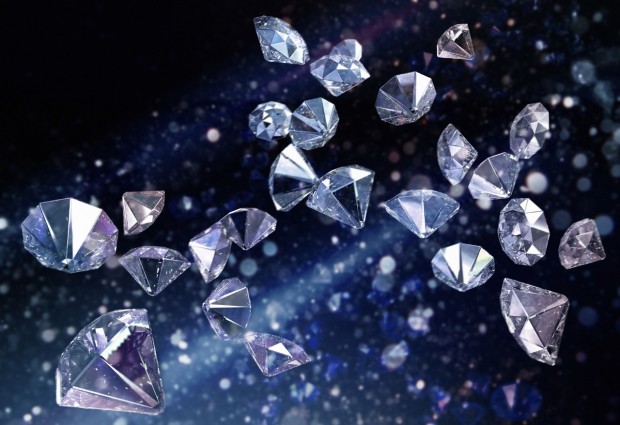How Human Remains Are Transformed Into Diamonds
For millennia, human remains have had great sentimental value, but most people would agree that they have very limited other value or use. Over the past couple of decades, diamond experts have worked hard to change that and make it possible to transform human ashes into diamonds.
Known as cremation diamonds or memorial diamonds, these treasured gemstones can be made using small portions of ashes that would normally be buried underground or left inside an urn.
A brief history of lab-grown diamonds
Lab-grown diamonds are nothing new. The first synthetic diamonds were made by General Electric (GE) in 1954 as part of Project Superpressure. But instead of being placed in jewelry settings, the stones became part of tools and were used for industrial purposes. GE continued to perfect its process until it created the very first gem-quality crystals in 1971.
Both the industrial and gem-quality lab-grown diamonds are made out of blocks of pure carbon, such as graphite. These two successes paved the way for gemstone specialists to create diamonds out of other sources comprised of carbon.
Diamonds from ashes
Between 1% and 4% of human remains is pure carbon. That may not sound like much, but only 0.35oz of carbon is needed to make a diamond. This amount of carbon can be found in just ½ cup of cremated ashes.
The amount of cremains needed to create a diamond stays the same, regardless of the carat weight, shape, or color of the diamond. This means that even if the human remains are divided between a number of people, there's still most likely enough for someone to turn their share into a diamond, should they choose to.
How natural diamonds are formed
The process of turning human remains into diamonds is a streamlined version of the way natural diamonds are formed. It's easier to understand the way cremation diamonds are made when you know how natural diamonds come to be.
There are natural carbon deposits 90-125 miles below the Earth's surface in the upper mantle. This part of the Earth is remarkably hot, due to being so close to the core. It's also under intense pressure, due to the weight of the overlying rock that bears down.
The high temperature and pressure act on the carbon and, over the process of millions and sometimes billions of years, turn it into a rough diamond. The gemstones are mined from the Earth and are cut and polished before they're ready for sale.
How cremation diamonds are made
The cremation diamond process imitates the natural diamond process in efficient and controllable lab conditions.
After the funeral has been held and the body has been cremated, a specialist company extracts pure carbon from the human remains. The carbon is then paired with a tiny diamond growing seed and placed into an HPHT (High-Pressure High-Temperature) machine. The HPHT machine duplicates the conditions found within the Earth's upper mantle.
Temperatures of up to 3,632℉ and pressures of up to 60,000 atmospheres (that's more than 880,000lbs per square inch) are applied to the extracted carbon and diamond growing seed. The high temperatures and pressures force the carbon atoms to reorganize themselves and form a diamond.
It takes around 10-18 weeks to create a diamond from ashes, depending on the carat weight, color, and shape. After the desired diamond has been produced, it's cut and polished to specification before being placed in a jewelry setting.
Are cremation diamonds real diamonds?
Just like lab-grown diamonds made from neutral sources of carbon are genuine diamonds, cremation diamonds made from human remains are real diamonds. Lab-grown, mined, and cremation diamonds are visually, physically, and chemically identical.
The only major difference from a chemical perspective is that while lab-grown and mined diamonds are made from unknown sources of carbon, cremation diamonds are made with carbon extracted from a loved one. This gives them unique, sentimental meaning.
To validate that cremation diamonds are genuine diamonds, most companies that create them issue certificates of authenticity. Each legitimate certificate includes a full diamond grading report and confirms the gemstone's origin.
Just like mined diamonds, most cremation diamonds also come with a lifetime warranty, ensuring that the gemstone was created in compliance with the exact requirements of the diamond growing technology. This guarantees that the diamond won't possess any defects, nor will it fade over time.
While all three kinds of diamonds may have the same physical, visual, and chemical elements, there are benefits that cremation and lab-grown diamonds have that natural diamonds just can't compete with.
When a diamond is created in a lab, the creator has much greater control over the quality of the gemstone, meaning the final diamond has fewer inclusions than any natural diamond. The diamond is also able to be fully customized. The carat weight, color, and intensity of color can all be custom-made to create the perfect diamond.
See Now: NASA's Juno Spacecraft's Rendezvous With Jupiter's Mammoth Cyclone
* This is a contributed article and this content does not necessarily represent the views of scienceworldreport.com





Join the Conversation